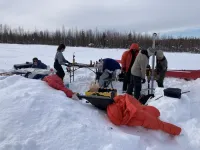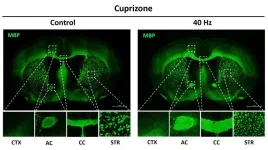(Press-News.org) RIVERSIDE, Calif. -- A traumatic brain injury, or TBI, is caused by a contusion to the head that may result in injury to the brain. This type of injury combined with the inherited genetic risk factors can result in the accelerated development of Alzheimer’s disease and related dementia, or ADRD. TBIs range from mild to severe, with the majority being mild. They are especially common in adolescents engaging in contact sports and in the elderly who tend to fall with greater frequency as they age. Regardless of the source, TBI and how it progresses to ADRD is an understudied area of research.
A $3.5 million grant to the University of California, Riverside, and Indiana University, from the National Institute of Neurological Disorders and Stroke at the National Institutes of Health will now examine how TBI at different ages and genetic risk factors leads to ADRD.
“There’s some literature that suggests that traumatic brain injury can evolve in some cases to Alzheimer’s or accelerate Alzheimer’s-like symptoms,” said Andre Obenaus, a professor of biomedical sciences at UCR’s School of Medicine and principal investigator of the three-year grant.
“We are interested in the complex interplay between TBI and genetic risk factors, and how these increase the susceptibility for individuals to develop Alzheimer’s disease and related dementia,” said Paul Territo, a professor of medicine at the Indiana University School of Medicine, and co-principal investigator of the proposed work.
Using rodents, Obenaus, Territo, and their teams will study three different time periods in the 24-month lifespan of a mouse: the juvenile age, which is postnatal Day 17; midlife, which is when the mice are 8-9 months old; and late life, which is when the mice are 12 months of age. The researchers will use cognitive behavioral outcomes, clinically relevant medical neuroimaging (PET/CT, MRI), immunopathology changes, and tissue biomarkers to assess disease progression.
“This system will allow us to investigate the interactions of how genetics and TBI in well characterized models across three epochs of lifespan influence progression to ADRD,” Obenaus said.
An expert on TBI, stroke, Alzheimer’s, and epilepsy, Obenaus has worked on TBI for more than two decades. He joined the UCR faculty in March 2024. He is a member of a National Institute of Aging-funded consortium, MODEL-AD, tasked with building better models of Alzheimer’s disease in mice. The consortium is based at UC Irvine.
Territo, an expert in Alzheimer’s disease, biomarker development, and therapeutics testing, has worked in both the academic and pharmaceutical industries developing rigorous and reproducible systems to evaluate disease progression and therapeutic response. These areas of expertise are extensively leveraged in the MODEL-AD consortium, where his lab characterizes mouse models of ADRD, and then performs therapeutic evaluation of novel drug candidates.
“We hope to identify early on those individual mice that will go on to have an Alzheimer’s-like phenotype,” Obenaus said. “We don’t expect all the mice to develop Alzheimer’s, but a certain subgroup of mice will. The goal is to identify the combinations of risk genes and timing of TBI that modulate fluid and imaging biomarkers involved so that early intervention is possible to prevent, or delay, progression of Alzheimer’s.”
Medical imaging is the only non-invasive means to assess both TBI and ADRD. When combined with fluid biomarkers, which are biological molecules found in body fluids and tissues, detection of abnormal processes or disease progression is possible. Obenaus explained that considerable research has been done on TBI, but scientists still do not fully understand its long-term progression and the biomarkers involved. Territo underscored the combined strength of linking the readouts of medical imaging, immunopathology, and fluid biomarkers into a comprehensive model, which will provide significant improvements in predictive validity in both TBI and ADRD.
“We now have sufficient technical expertise in the field to address this research problem, allowing us to better define TBI and its role in initiating Alzheimer’s disease,” Obenaus said. “In addition, over the past two decades there has been a wealth of research identifying the two main proteins, tau and amyloid, thought to interfere with the communication between brain cells, and leading to ADRD.”
Obenaus and Territo said the data from the research project will be aggregated and made freely available to other researchers through the NIH Open Science framework.
They will be joined in the research project by Adam Godzik and Devin Binder, who are professors of biomedical sciences in the UCR School of Medicine. A research team at the Uniformed Services University of the Health Sciences in Maryland, led by Dr. Denes Agoston, will work on the project as well. Also joining the team is Talin Babikian, a neuropsychologist at UCLA, who has extensive experience in TBI and its progression. Graduate students and postdoctoral researchers at UCR and Indiana University also will work on the research project.
Research reported in this news release was supported by the National Institute of Neurological Disorders and Stroke of the National Institutes of Health under Award Number RF1NS138032. The content does not necessarily represent the official views of the National Institutes of Health.
The University of California, Riverside is a doctoral research university, a living laboratory for groundbreaking exploration of issues critical to Inland Southern California, the state and communities around the world. Reflecting California's diverse culture, UCR's enrollment is more than 26,000 students. The campus opened a medical school in 2013 and has reached the heart of the Coachella Valley by way of the UCR Palm Desert Center. The campus has an annual impact of more than $2.7 billion on the U.S. economy. To learn more, visit www.ucr.edu.
END
How does traumatic brain injury progress to Alzheimer’s disease?
An NIH grant to UC Riverside and Indiana University will explore the question
2024-08-08
ELSE PRESS RELEASES FROM THIS DATE:
Researchers find unexpectedly large methane source in overlooked landscape
2024-08-08
When Katey Walter Anthony heard rumors of methane, a potent greenhouse gas, ballooning under the lawns of fellow Fairbanks residents, she nearly didn’t believe it.
“I ignored it for years because I thought ‘I am a limnologist, methane is in lakes,’” she said.
But when a local reporter contacted Walter Anthony, who is a research professor at the Institute of Northern Engineering at University of Alaska Fairbanks, to inspect the waterbed-like ground at a nearby golf course, she started to pay attention. Like others in Fairbanks, they lit “turf bubbles” on fire and confirmed the presence of methane ...
Royal Commission for AlUla collaborates with SETI Institute to support development of Alula Manara Observatory
2024-08-08
Royal Commission for AlUla Collaborates with SETI Institute to Support Development of AlUla Manara Observatory
Experts from SETI Institute will support the advancement of telescope technology and data analysis at AlUla Manara Observatory.
The collaboration will enhance the future observatory's capabilities as it welcomes global scientists, researchers, and tourists interested in astronomy and space science.
Ambitions to foster curiosity, knowledge sharing, and upskilling local capabilities in astronomical and space sciences field
Mountain View, CA , 8 August 2024 -- The Royal Commission for AlUla (RCU) and SETI Institute ...
Cutting a few calories won’t hurt your workout
2024-08-08
A new UC Riverside study demonstrates that calorie restriction doesn’t deter mice from exercising, challenging the belief that dieting drains workout energy.
The study, published in the journal Physiology & Behavior, shows that cutting calories by 20% did not significantly reduce the distance that mice voluntarily chose to run each day.
The researchers set out to understand what happens to mice when the amount of food available to them is reduced. The findings, they hoped, would be relevant ...
Study reveals ways in which 40Hz sensory stimulation may preserve brain’s ‘white matter’
2024-08-08
Early-stage trials in Alzheimer’s disease patients and studies in mouse models of the disease have suggested positive impacts on pathology and symptoms from exposure to light and sound presented at the “gamma” band frequency of 40 Hz. A new study zeroes in on how 40Hz sensory stimulation helps to sustain an essential process in which the signal-sending branches of neurons, called axons, are wrapped in a fatty insulation called myelin. Often called the brain’s “white matter,” myelin protects axons and insures better ...
Record-breaking recovery of rocks that originated in Earth’s mantle could reveal secrets of planet’s history
2024-08-08
Scientists have recovered the first long section of rocks that originated in the Earth’s mantle, the layer below the crust and the planet’s largest component.
The rocks will help unravel the mantle’s role in the origins of life on Earth, the volcanic activity generated when it melts, and how it drives the global cycles of important elements such as carbon and hydrogen, according to the team.
The nearly continuous 1,268 metres of mantle rock was recovered from a “tectonic window,” a section ...
Surprise: infected bacteria fight back with “hidden” genes that halt cell growth, slow viral spread
2024-08-08
Researchers have uncovered a surprising way bacteria defend themselves: when a bacterium is infected, bacterial enzymes that copy genetic information from RNA into DNA synthesize genes whose protein products help shut down cell growth. This prevents further viral spread in the neighboring bacterial population. The results highlight the potential for other “hidden” genes, like the one found here, to be unearthed in different biological contexts. Bacteria defend themselves from viral ...
Early prenatal exposure to famine increases Type 2 diabetes risk in adulthood, shows study of historical Ukraine event
2024-08-08
Prenatal exposure to famine significantly increases the risk of developing Type 2 diabetes mellitus (T2DM) in adulthood, according to a new study of people impacted by the 1932-1933 Holodomor famine in Ukraine. While the immediate and short-term effects of famines on mortality and morbidity are well-documented, deciphering famines’ long-term health consequences – as this study did – has been more difficult. Previous research has suggested a link between prenatal nutrition and adult health ...
Marine algae use massive enzymes of unprecedented size to biosynthesize fish-killing toxins
2024-08-08
Marine algae Prymnesium parvum use massive enzymes dubbed PKZILLAs – some of the largest proteins ever to be identified in nature – to make large and complex prymnesin neurotoxins responsible for mass fish kills during harmful algal blooms worldwide, researchers report. “The discovery and initial characterization of the prymnesin PKZILLA gigasynthases now elucidates the long-standing question about how microalgae biosynthesize their giant polyketide polyether molecules,” write the authors. It also expands ...
Record-breaking 1.2-kilometer drill core unveils new insights into Earth's mantle
2024-08-08
A record-breaking 1268-meter drill core into Earth’s mantle, collected from the Mid-Atlantic Ridge in the North Atlantic, has provided a deep and detailed mineralogical glimpse of the oceanic mantle. The findings reveal new insights into mantle composition, Earth’s deep geology, and the potential biogeochemical conditions involved in the origins of life. Understanding the Earth’s mantle is crucial for comprehending important details of the Earth system, including terrestrial magmatism, crust formation, and the cycling ...
American College of Cardiology issues guide for managing in-patient heart failure
2024-08-08
The American College of Cardiology has issued updated guidance on managing patients hospitalized for heart failure (HF) to provide a decision-making pathway that tailors therapy to clinical trajectory to better manage disease. The updated Expert Consensus Decision Pathway incorporates the latest evidence to provide guidance for clinicians to use at the point of care in conjunction with the 2022 ACC/AHA Heart Failure Guideline.
Heart failure refers to several conditions that can affect the way the heart works, its structure or both. Over time, heart failure makes ...
LAST 30 PRESS RELEASES:
Autistic and non-autistic faces may “speak a different language” when expressing emotion
No clear evidence that cannabis-based medicines relieve chronic nerve pain
Pioneering second-order nonlinear vibrational nanoscopy for interfacial molecular systems beyond the diffraction limit
Bottleneck in hydrogen distribution jeopardises billions in clean energy
Lung cancer death rates among women in Europe are finally levelling off
Scientists trace microplastics in fertilizer from fields to the beach
The Lancet Obstetrics, Gynecology, & Women’s Health: Taking paracetamol during pregnancy does not increase risk of autism, ADHD or intellectual disabilities, confirms new gold-standard evidence review
Taking paracetamol during pregnancy does not increase risk of autism, ADHD or intellectual disabilities
Harm reduction vending machines in New York State expand access to overdose treatment and drug test strips, UB studies confirm
University of Phoenix releases white paper on Credit for Prior Learning as a catalyst for internal mobility and retention
Canada losing track of salmon health as climate and industrial threats mount
Molecular sieve-confined Pt-FeOx catalysts achieve highly efficient reversible hydrogen cycle of methylcyclohexane-toluene
Investment in farm productivity tools key to reducing greenhouse gas
New review highlights electrochemical pathways to recover uranium from wastewater and seawater
Hidden pollutants in shale gas development raise environmental concerns, new review finds
Discarded cigarette butts transformed into high performance energy storage materials
Researchers highlight role of alternative RNA splicing in schizophrenia
NTU Singapore scientists find new way to disarm antibiotic-resistant bacteria and restore healing in chronic wounds
Research suggests nationwide racial bias in media reporting on gun violence
Revealing the cell’s nanocourier at work
Health impacts of nursing home staffing
Public views about opioid overdose and people with opioid use disorder
Age-related changes in sperm DNA may play a role in autism risk
Ambitious model fails to explain near-death experiences, experts say
Multifaceted effects of inward foreign direct investment on new venture creation
Exploring mutations that spontaneously switch on a key brain cell receptor
Two-step genome editing enables the creation of full-length humanized mouse models
Pusan National University researchers develop light-activated tissue adhesive patch for rapid, watertight neurosurgical sealing
Study finds so-called super agers tend to have at least two key genetic advantages
Brain stimulation device cleared for ADHD in the US is overall safe but ineffective
[Press-News.org] How does traumatic brain injury progress to Alzheimer’s disease?An NIH grant to UC Riverside and Indiana University will explore the question




